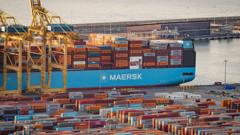Both the US and the EU have successfully negotiated a critical trade deal, which comes as the US prepares for further tariff discussions with China. The agreement, finalized on Sunday after intensive negotiations led by President Donald Trump and European Commission President Ursula von der Leyen, is a testament to the importance of their economic partnership.
Trading dynamics between the two regions are substantial; many businesses and jobs rely on this relationship, which is often termed the world's largest bilateral trade. For the US, the deal is projected to generate significant revenue—estimated at $90 billion based on last year's trade statistics—while the EU could potentially avoid more severe tariffs that had been threatened at up to 30%.
Both leaders have hailed the deal as a victory. However, the intricacies lie in the details yet to be disclosed—such as the timeline and areas of EU investment in the US. These specifics could determine how successful the agreement truly is.
The US imposes a trade deficit that saw imports from the EU exceed exports by $236 billion last year, a situation Trump often cites as an issue of American wealth. The US is also wary of the EU's stringent regulations that can inhibit American companies from accessing the European market. The continued trading imbalance and regulatory challenges point to the complexity of international trade relations, which is expected to be addressed further.
Ursula von der Leyen acknowledged the need for a balanced relationship while announcing the agreement. She stated, “We will make it more sustainable," hinting at the necessity for adjustments in ongoing negotiations to maintain long-term trade fairness.
As positive energy from this agreement fuels upcoming negotiations with trading partners like China, there remains a possibility that negotiations could take longer if disagreements arise, leading to unstable global trade relations in the near future. The next round of US-China trade talks is expected shortly, with speculation of a temporary suspension of tariffs but uncertainty surrounding the outcome remains.
Trading dynamics between the two regions are substantial; many businesses and jobs rely on this relationship, which is often termed the world's largest bilateral trade. For the US, the deal is projected to generate significant revenue—estimated at $90 billion based on last year's trade statistics—while the EU could potentially avoid more severe tariffs that had been threatened at up to 30%.
Both leaders have hailed the deal as a victory. However, the intricacies lie in the details yet to be disclosed—such as the timeline and areas of EU investment in the US. These specifics could determine how successful the agreement truly is.
The US imposes a trade deficit that saw imports from the EU exceed exports by $236 billion last year, a situation Trump often cites as an issue of American wealth. The US is also wary of the EU's stringent regulations that can inhibit American companies from accessing the European market. The continued trading imbalance and regulatory challenges point to the complexity of international trade relations, which is expected to be addressed further.
Ursula von der Leyen acknowledged the need for a balanced relationship while announcing the agreement. She stated, “We will make it more sustainable," hinting at the necessity for adjustments in ongoing negotiations to maintain long-term trade fairness.
As positive energy from this agreement fuels upcoming negotiations with trading partners like China, there remains a possibility that negotiations could take longer if disagreements arise, leading to unstable global trade relations in the near future. The next round of US-China trade talks is expected shortly, with speculation of a temporary suspension of tariffs but uncertainty surrounding the outcome remains.





















